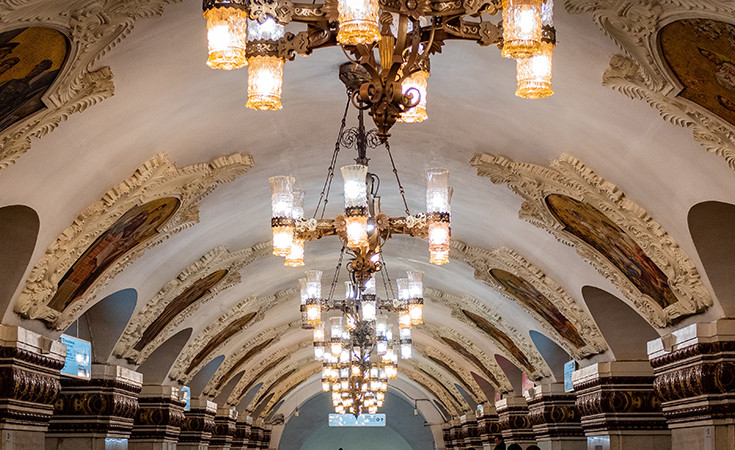The Moscow Metro is notable for many reasons: it is the fifth most frequented metro, just behind metros in Tokyo, Beijing, Shanghai, and Seoul, and is officially the most beautiful metro of the world due to the realization of design ideas of individual stations which display artwork in the style of realism. The first metro line was opened on the 15th May 1935, with many stations changing names, some of them being renamed several times.
The Moscow metro system consists of 17 lines (including the Moscow monorail and the Central ring of Moscow), totaling around 456km in length. The metro has 256 stations, 44 of which are considered cultural heritage sites. The Moscow metro enables around 8 million commuters use its services every day. It is an unbelievable feat of engineering which was subsequently decorated by many famous Russian artists, including Alexey Schusev, Pavel Korin, Alexey Dushkin and Aleksandr Deyneka. It is fascinating that a metro station can contain so many art pieces, including paintings, marble and bronze statues, stained glass, mosaics. Commuters don’t have the impression that they’re in a metro, but rather, they feel like they have found themselves in a beautiful gallery or museum, and the only thing that can convince them otherwise is the sound of the trains.
The most beautiful metro stations that you shouldn’t miss:
- Komsomolskaya – The name comes from the word “komsomol”, which is the shortened form of the Russian for “youth communist organization”. This incredible station with an unusually high ceiling is painted in bright yellow, with stained glass which complete the experience;
- Kievskaya – The name comes from the town of Kyiv in the Ukraine because of the fact that it was in Kyiv that the contest for the ideal design of the station took place. The mosaics of this stations are astonishing, representing both Russian and Ukrainian cultures and traditions;
- Taganskaya – This station is painted in royal-blue and gold. Although many claim, including some tourist brochures, that the colors represent traditional Russian motifs and colors, the colors actually represent the harmony characteristic of Byzantine artwork, the many mosaics on buildings and churches that were once built in Constantinople;
- Arbatskaya – Located beneath the cultural center of the city, the Arbat Street, where the most notable Russian artists once lived, this station is characteristic for the milk-white color of its decorated walls, incredible lantern from the 20th century, and lavishly decorated mosaics. The station was supposed to serve as a bomb shelter in case Moscow was bombed during World War Two.
- Novoslobodskaya – This station is characteristic for its strong marble slabs that further accentuate the stained glass work done by Latvian artists. It is clear that the stained glass objects aren’t consistent with Russian tradition, but visitors admire them for their cheerful colors contrasted with the slight darkness of the metro.
- Park Pobedy – Another station that you should definitely see, this station is the deepest station in the Moscow metro, reaching a depth of 85 meters.
Interesting facts
The chief engineers in the metro construction were British. During the construction, Stalin constantly issued arrest warrants, accusing the British engineers of espionage. In the end, the British engineers who worked on the metro were all deported back to Great Britain.
photo credit: David Torres
